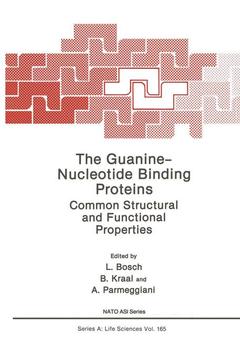Description
The Guanine — Nucleotide Binding Proteins, Softcover reprint of the original 1st ed. 1989
Common Structural and Functional Properties
Coordinator: Bosch L.
Language: English
Subject for The Guanine — Nucleotide Binding Proteins:
Keywords
Nucleotide; primary structure; protein; protein synthesis; proteins; receptor; synthesis
Publication date: 04-2013
409 p. · 17.8x25.4 cm · Paperback
409 p. · 17.8x25.4 cm · Paperback
Description
/li>Contents
/li>
This volume contains the proceedings of the EMBO-NATO-CEC Advanced Research Workshop on "Guanine-nucleotide binding proteins. Common structural and functional properties", which was held in Renesse, The Netherlands, August 6-11, 1988. The transmission of information is one of the most important processes in cellular life and involves the most diverse physiological functions. The cellular membrane, as the obligatory target for external signals, harbours complex pathways transducing the signals from the receptors of the external stimuli to the cytoplasmic effector. Heterotrimeric proteins are fundamental components of these pathways. Other proteins that are monomeric may be found associated with the membrane or in soluble form in the cytoplasm, and' can also function in signal transduction. Intracellular transmission of signals may proceed in an analogous fashion, protein synthesis being a well-known example. It is one of the most remarkable and puzzling observations of recent years that all of these proteins share common properties, both functionally and structurally. The ir primary structures show pronounced s imilari ties, in most cases concentrated in the NH2-terminal portion of the molecule. They all bind guanine nucleotides (hence the general name of G-proteins) and are GTPases, a crucial enzymatic activity, since it converts the active complex induced by GTP into the inactive one induced by GDP. Consensus sequences have been ident if ied as responsable for interact ing with the different parts of the guanine nucleotide.
New Structural Data on Elongation Factor-Tu:GDP Based on X-ray Crystallography.- Progress on the Three-Dimensional Structural Determination of Trypsin-Modified EF-Tu-GDP.- Three-Dimensional Structure of ras p21 Proteins.- The GTP-Binding Domain Revisited.- Novel Mutants of EF-Tu.- The Elongation Factor EF-Tu from E. coli Activates the tRNA-tufB Operon in Trans by Binding to a Cis-Acting Region Upstream of the Promoter.- Structure-Function Relationships of the GTP-Binding Domain of Elongation Factor Tu.- A Mutation that Hinders the GTP Induced Aminoacyl-Trna Binding of Elongation Factor Tu.- The Application of Fluorescent and Photosensitive Analogues of Guanine Nucleotides to the Function and Structure of G-Binding Proteins.- Affinity Labeling of the GDP/GTP Binding Site in Thermus thermophilus Elongation Factor Tu.- Characterization of Elongation Factor Tu from Bacillus subtilis Modified by Affinity Labeling.- Effects of Kirromycin on the Elongation Factor EF-Tu and its Interactions with GDP or GTP and tRNA. The Application of Zone-Interference Gel Electrophoresis, a New Method for the Analysis of Weak Complexes.- Factors and Ribosomes: Their coupling and Mode of Signal Processing.- The Structure and Regulation of Mammalian Initiation Factor eIF2.- Structure of the Human ras Gene Family.- A Mutational Analysis of ras Function.- Analysis of the Biochemical and Biological Activities of Deletion Mutants of the H-ras p21 Protein Suggest that GAP is an Essential Component of its Effector Function.- Purification and Molecular Cloning of Bovine GAP.- The Function of the Mammalian ras Proteins.- Biochemical Properties of Ha-ras Encoded p21 Mutants.- Structural and Functional Studies on c-p21, v-p21 and the and Genetically Engineered Guanine Nucleotide Binding Domain of EF-Tu.- Structure and Function of ras p21: Studies by Site-Directed Mutagenesis.- The Cyclic AMP Producing Pathway in Saccharomyces cerevisiae Involves CDC25 and ras Genes Products.- Mutations at the RAS2 Locus that, in a ras1- Background, Impair the Growth of Yeast on Nonfermentable Carbon Sources.- Structural and Functional Analysis of ypt Proteins, a Family of ras-Related Nucleotide-Binding Proteins in Eukaryotic Cells.- Analysis of the ras Gene Function in Dictyostelium discoideum.- Identification of Guanine-Nucleotide Binding Proteins in Plants: Structural Analysis and Evolutionary Comparison of the ras-Related ypt-Gene Family from Zea mays.- Does HIV nef Protein Belong to the G-Protein Family?.- Structure and Function of G Proteins from Mammalian and Yeast Cells.- Three Forms of Gi Discriminated by Synthetic Peptide Antisera.- Identification of Functional Domains in G Protein ? Chains.- Behavior of Membrane Guanine-Nucleotide Binding Proteins as Signal Transducers.- Transducin: the Molecular Switch in Visual Excitation and a Model for Biological Coupling Enzymes.- A Novel Cytosolic GTP-Binding Protein with Phospholipid Stimulated GTP-Binding and GTPase Activity.- Role of a G Protein Homolog in Yeast Pheromone Response.- Signal-Transducing G-Proteins in Dictyostelium discoideum.- Tubulin as a G-Protein: Regulation of Tubulin-Tubulin Interactions by GTP Hydrolysis.- Tubulin Structure and Nucleotide Binding.- Tubulin as a G Protein?.- Author Index.
© 2024 LAVOISIER S.A.S.
These books may interest you

The Rho GTPases in Cancer 158.24 €

Rab GTPasesMethods and Protocols 105.49 €

Rab GTPasesMethods and Protocols 116.04 €

